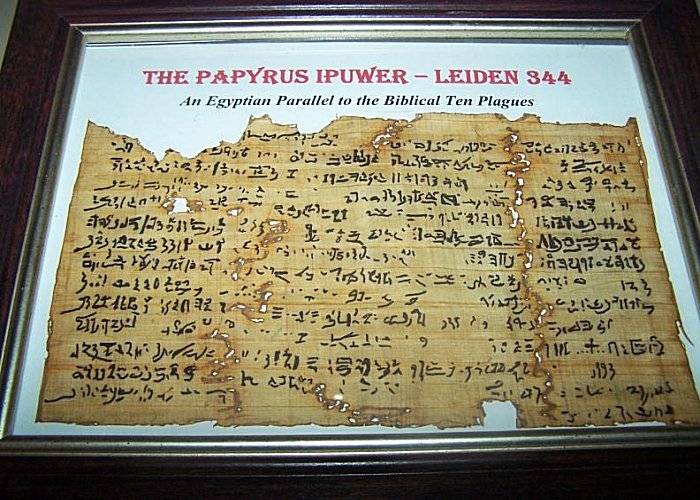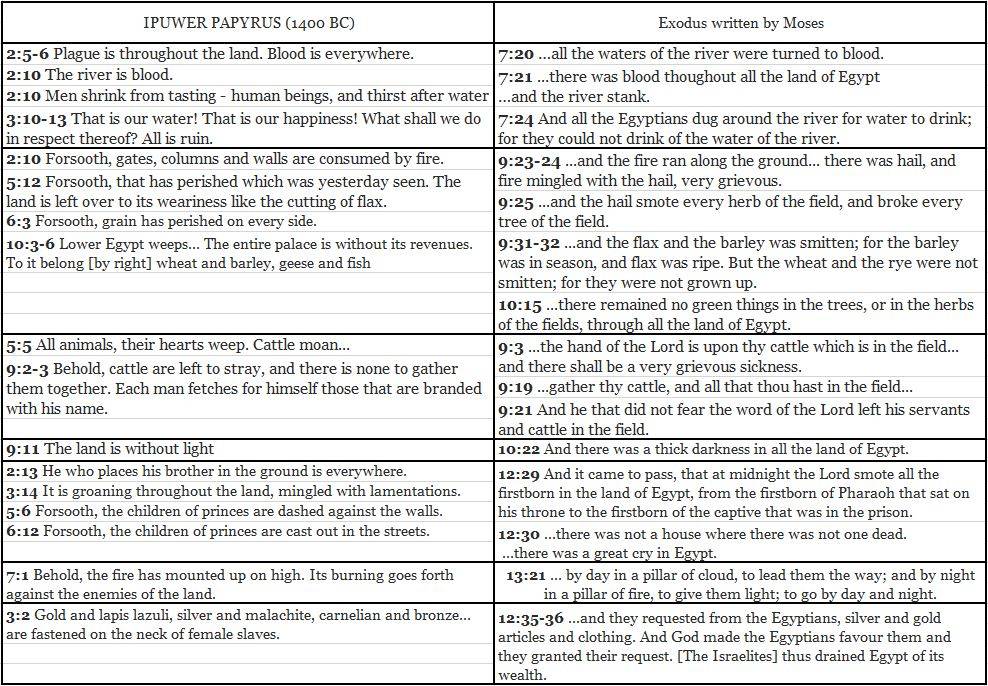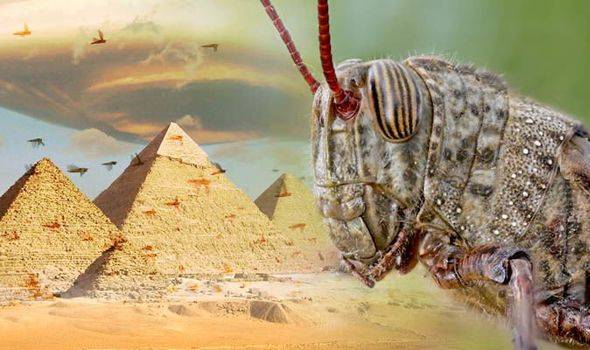The Plagues of Ipuwer
A Comparative Perusal of “The Admonitions of Ipuwer” and “The 10 Biblical Plagues on Egypt”
Here’s what we’ll discuss:
What is the Ipuwer Papyrus?

The Ipuwer Papyrus is an ancient Egyptian written in Egyptian hieratic text by the scribe Ipuwer. As it is often called a poem due to its consistent writing style.
It has been dated to the Nineteenth Dynasty, around 1250 BCE but It is known to be a copy of a much older text, most estimates dating back to the Middle Kingdom 1850 BCE and 1600 BCE. He tells a lengthy story of absolute calamity befalling Egypt.
The renowned British Egyptologist Sir Alan Gardiner (1879-1963) translated the Ipuwer Papyrus into English in 1909. He believed that the text contained historical descriptions of current and past events.
Ipuwer himself called it “The Admonitions of an Egyptian Sage”. Says itself that it is a copy of earlier work. It is especially valuable for its commentary on woeful contemporary political and economic situations, perhaps those prevalent in Egypt during the First Intermediate Period (c. 2130–1938 BCE).
Another popular claim is that is a fictional literary piece or king appointed propaganda. Based on what was going on at the time in Egypt through other texts and artifacts. Egypt was very stable and at the heights of their dynasty when the papyri were written.

Proof of the biblical plagues? or another biblical inspiration resource?
The Ipuwer Papyrus is often cited as evidenced of the Torah account by biblical scholars. One could relate the papyrus as a reaction of an Egyptian to the biblical plagues when looking at the similarities. But the differences indicate that either major omissions and modifications were made, or they are referring to two separate events.
The Biblical Plagues are the ten catastrophes imposed on ancient Egypt to let the Israelite slaves go, as recorded in the Torah, Exodus: Chapters 7–12.
The Ipuwer Papyrus is a written account of events in Kemet (ancient Egypt) by the scribe Ipuwer. It describes an affliction of Egypt by natural disasters and the chaos that followed.
Many references throughout the papyrus are strikingly similar to the biblical account of the 10 plagues.
Time Discrepancy Issue
There is a major time discrepancy with when biblical scholars date the exodus, and the much earlier estimated date of the original papyri. https://jewishaction.com/letters/when-was-the-exodus/

While the events in the Papyri (if they actually happened) are dating back to the Middle Kingdom 1850 BCE.
The very earliest date for the Exodus proposed by the most conservative scholars is 1450 BCE. Scholars in the tradition of the celebrated biblical archaeologist William F. Albright (1891-1971) propose an alternative, “late” Exodus around 1200-1250 BCE.
These dates would lead to reason that the papyrus more likely inspired the biblical story, than was describing the same event.
Comparison of the Ipuwer and Exodus Texts

On a literal reading, there are similar descriptions, and concepts in the Ipuwer Papyrus and the Exodus account of the plagues of Egypt.
The first plague (turning the Nile to blood).

(Exodus 7:17) “This is what the Lord says: By this you will know that I am the Lord: With the staff that is in my hand I will strike the water of the Nile, and it will be changed into blood.”
(IP 2:10) Indeed the river is blood, yet men drink of it. Men [shrink] from human beings and thirst for water.
(IP 2:5–6) “Plague is throughout the land. Blood is everywhere”
(IP 3:10–13) “That is our water! That is our happiness! What shall we do in respect thereof? All is ruin”
The fourth plague (Locusts Infestation)
(Exod. 10:15) “They covered all the ground until it was black. They devoured all that was left after the hail—everything growing in the fields and the fruit on the trees. Nothing green remained on tree or plant in all the land of Egypt.”
(IP) “Neither fruit nor herbage can be found… everywhere barely has perished.”
(IP 6:3) “Forsooth, grain has perished on every side, no fruit or herbs were found”
(IP 5:12) “Forsooth, that has perished which was yesterday seen. The land is left over to its weariness like the cutting of flax”
(Exod. 11:5) “Every firstborn son in Egypt will die, from the firstborn son of Pharaoh, who sits on the throne, to the firstborn son of the female slave, who is at her hand mill, and all the firstborn of the cattle as well.”
(IP) “Indeed men are few, and he who places his brother in the ground is everywhere… Indeed [hearts] are violent, pestilence is throughout the land, blood is everywhere, death is not lacking, and the mummy-cloth speaks even before one comes near it.”
The fifth plague (the death of livestock)

(Exodus 9:3-6) the hand of the Lord will bring a terrible plague on your livestock in the field—on your horses, donkeys and camels and on your cattle, sheep and goats. 4 But the Lord will make a distinction between the livestock of Israel and that of Egypt, so that no animal belonging to the Israelites will die. 5 The Lord set a time and said, “Tomorrow the Lord will do this in the land.” 6 And the next day the Lord did it: All the livestock of the Egyptians died, but not one animal belonging to the Israelites died.
(IP 5:5): “Indeed, all animals, their hearts weep; cattle moan because of the state of the land.”
(IP 9:2–3) “Behold, cattle are left to stray, and there is none to gather them together “
The seventh plague (hail and fire)

(Exod. 9:23) “When Moses stretched out his staff toward the sky, the LORD sent thunder and hail, and lightning flashed down to the ground. So the LORD rained hail on the land of Egypt.”
(IP) “Indeed, gates, columns, and [walls] are burnt up… Behold, the fire has gone up on high, and it’s burning goes forth against the enemies of the land.”
(IP) “Fire ran along the ground. There was hail and fire”
(IP 2:10) “Forsooth, gates, columns and walls are consumed by fire”
(Exod. 9:25) “Throughout Egypt hail struck everything in the fields—both people and animals; it beat down everything growing in the fields and stripped every tree.”
(IP) “Indeed, trees are felled and branches are stripped off.”
The ninth plague (darkness)

(Exod. 10:22) “So Moses stretched out his hand toward the sky, and total darkness covered all Egypt for three days.”
(Exodus 10:22–23) For three days, the land of Egypt was smothered with an unearthly darkness, but the homes of the Israelites had light.
(IP 9:11) The Ipuwer Papyrus says, “The land is without light” .
(IP) “[The land] is not bright because of it.”
The tenth and last plague (the death of firstborn males)
(Exodus 12:23) “Every household that did not apply the blood of the Passover sacrifice saw the death of the firstborn.”
(IP 4:3 and 5:6) “Forsooth, the children of princes are dashed against the walls”
(IP 6:12) “Forsooth, the children of princes are cast out in the streets”.
(IP 2:13) “He who places his brother in the ground is everywhere”.
(Exodus 12:30) “There was a great cry in Egypt”
(IP 3:14) “It is groaning throughout the land, mingled with lamentations”
Coincidences?
Not conclusive in the least. Far from the almost carbon copies, we find in proverbs and exodus in the Instructions of Amenemope and the Papyri of Ani.
But there are remarkable similarities between the unique catastrophes described in the Ipuwer Papyrus and the biblical narrative of the Plagues of Egypt that can’t be denied.
Are these records of precisely the same events?

This is unlikely since the probable date of the composition of the Papyrus, 1850 BCE and 1600 BCE, precedes the date of the Exodus by centuries.
There is nothing particularly miraculous about the conditions described by Ipuwer, nor is there any mention of slaves, Passover, and other details covered in the bible.
As it often does, I guess it comes down to if you believe in coincidences. Such strong coincidences are hard to overlook, especially with the bible’s tendencies to extrapolate and modify previous texts and concepts.
Biblical Scholars often dismiss similarities in ancient texts, and they also maintain the option argue the multiple dating techniques used throughout archaeology, Many even restructure the complete biblical timeline in an attempt to force a fit.
Dr. John Van Seters, Distinguished Professor Emeritus at the University of North Carolina, suggests that an author he calls the Jahwist (J) wrote the base-story of the Exodus in the 6th century BCE. This was later expanded by the Priestly school of writers (P) in the redacting of the Torah.
If Dr. Van Seters is correct, then the Ipuwer Papyrus may precede the biblical text by as much as a millennium.
What do you think?
If you like, dislike or have thoughts to add please lead the discussion below.






